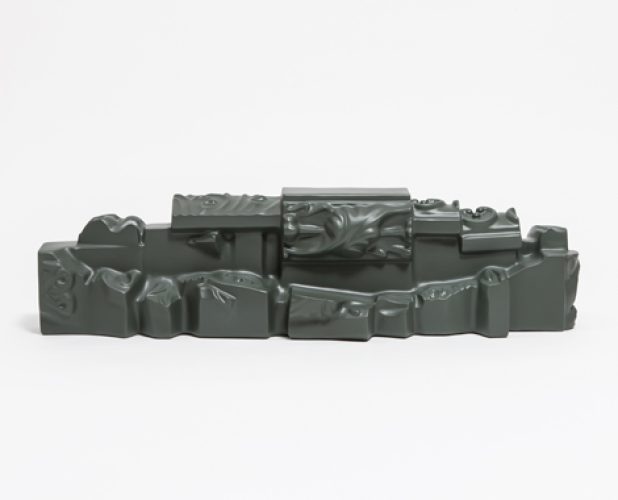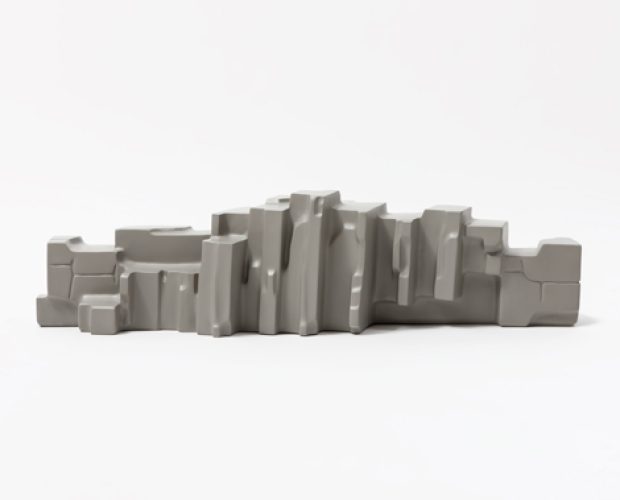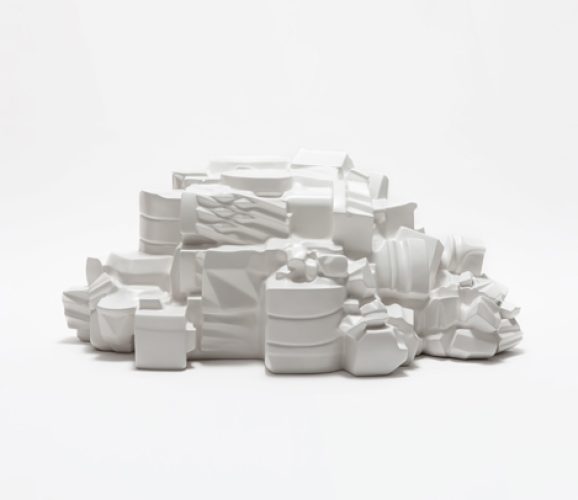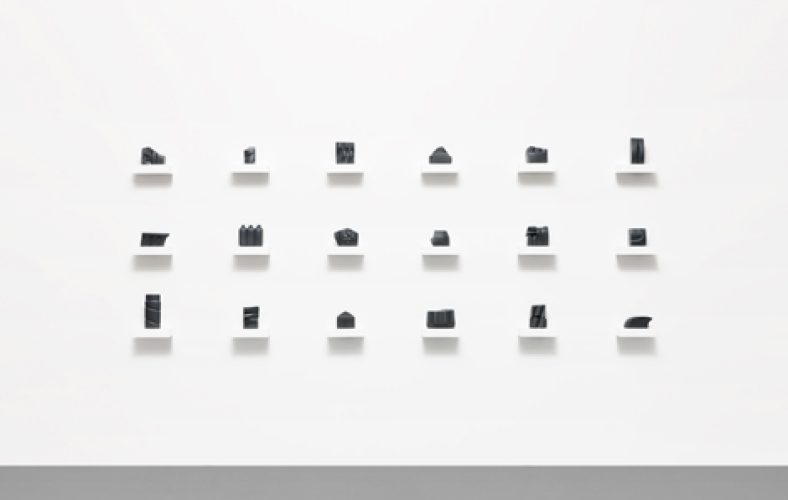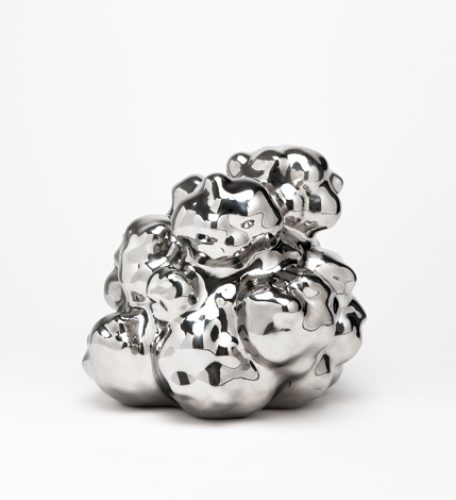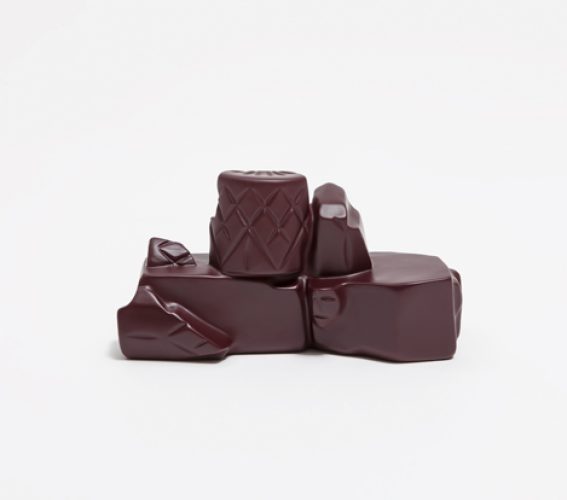The ‘Landscape Sculpture’ that Expresses the Relations
Between Humans and Nature
Let’s begin with this somewhat unfamiliar phrase – ‘landscape sculpture.’ The word, ‘landscape,’ which refers to the natural features viewed by men or certain sceneries and situations, usually makes a pair with paintings (photos) not sculptures. In other words, the appropriate medium to recreate a scenery is generally a visually-centered painting (photo) as two-dimensional image, not a three-dimensional form of sculpture which values sense of touch more than vision, and material more than image. Sculptor Kangwon Lee, however, calls his entire works ‘landscape sculpture.’ Then, what is the landscape that he refers to and why is it landscape sculpture not landscape painting (photo)? Also what is he trying to show through his landscape sculpture? This article will find out the meaning and reason which will be the interpretation and demonstration of this artist’s art world.
When it comes to landscape painting (landscape photography) being as one of the traditional genres of visual art, generally a landscape refers to a single two-dimensional image formed by the perspective visual system. That is, space and objects in the space viewed from a certain distance are recreated on a single plane according to the distance – whether near or far. However, when we face an actual landscape, we don’t stop at one spot and don’t perceive the view before our eyes as a piece of visual image like when we take a picture or draw a painting of a landscape. Rather, we move ourselves to look around, touch objects nearby and smell the air to feel the whole atmosphere and the scenery perceived in this way is remembered as different memories depending on the person. That is, the actual landscape, not the grammar of a genre, is a three-dimensional memory remembered by the whole senses not a two-dimensional image visually dependent. The landscape that Kangwon Lee demonstrates is the landscape in this sense. And he sculpts landscapes in his own way; he gives shapes to certain parts of the landscape that he remembers – usually in sizes as small as he can make with his hands and he combines these pieces of the landscape to create another new landscape. The pieces or sculptures that form the landscape are sometimes patterned after the actual shapes, or from his imagination or sometimes just atypical elements that form the whole shape. However, these are independent pieces that have completion and materiality as a shape and become a new landscape as a gathering of a mass of materials and also a single image when they are combined. This is the artist’s unique ‘landscape’ which reinterprets images as objects.
In contrast to the particular concept ‘landscape sculpture,’ the artist holds on to the sculpture’s essence as a medium when he practically produces sculptures. The comparison that he makes as he explains the sculpture to natural phenomena ‘rolling’ and ‘flowing’ is quite interesting. While the ‘sculpture’ made through cutting out solid materials is like the way that a rock rolls and becomes more round and smaller, ‘modeling’ which is shaping and adding soft materials and ‘casting’ which is pouring and hardening liquid materials into a frame made by modeling are like mud being deposited by running water and the hot lava flowing and getting solidified along the face of the earth respectively. The artist has entrusted his hands to these natural principles of rolling and flowing to create his art works. His previous works well show this journey; <Sunrise-Sunset>(2005), which was presented by arranging the artist’s various personal objects made by carving rubber sponge on the floor of the exhibition room and drawing their shadows with the use of dark rubber powders left during the production process to complete the entire landscape, is one of his representative ‘rolling’ works. The views inside his room were sculpted into objects of his memories and then were re-arranged in the exhibition hall with shadows and became a completely new landscape. Although the objects were casting their shadows in the same direction like a bright light comes from one direction and shines over a dark space, the exhibition area was actually very bright and the objects and shadows were all dark, making unrealistic scenery. In addition, in this scenery in which light and darkness coexist, the shadows are an image created by the objects and the practical materials made by the artist at the same time – this has deepened the paradox of the scene. Meanwhile, his well-known ‘oil pastel’ work represents the ‘flowing.’ His ‘flowing’ work completed by the processes of molding and casting produces a new solid-color scenery by melting oil pastel (commonly, crayons) of a particular color by heat and pouring it into frames made beforehand and solidifying them and arranging these pieces of different shapes on a pedestal. (It is one of this work’s characteristics that the color of the original pigment of the oil pastel is used to complete a colored sculpture without the process of coloring.) Like the titles <Skyline>(2005) or <Forest>(2006) reflects, it is an image of a horizontal scenery with its overall outlines accented and yet each piece that forms the entire landscape is also a lump of materials that represent unexpected artifacts like a fragment of relics or missiles. Eventually the world filled with artificial objects made by men is being compared to the landscape of the nature.
These characteristic aspects of Kangwon Lee’s ‘landscape sculpture’ have consistently been applied from his previous to recent works. In his personal works which will be exhibited under the title of <The Reverse Side of Landscape>, he keeps this consistency and yet shows considerable changes for the landscapes that he has created are way more profound and wider. To be more specific, he concentrated on the ‘flowing’ work which focuses on molding and casting and yet he, in many ways, tries to make thresholds and changes compared to his previous works and has extended the range and implication of the overall world of his works. His representative works including <Forest>(2014), <Land>(2014), and <Water>(2013) remind one of the comprehensive meaning of nature because of their titles and overall images of sceneries whereas the shapes of each piece that complete the landscape are the specific objects that we see in our everyday lives.
For example, the <Forest> comprises the molding decorations for indoor space patterned after the stem of climbing plants, trees, flowers, etc. and pieces made in shapes of the patterns of wallpaper. The <Land>, as well, is formed by the various shapes of interior materials such as wallpaper, floor, and tiles that are patterned after rocks, pebbles, and sand through the artist’s diverse views. He stated that from the construction waste produced while demolishing his house, he came to learn the fact that many of the materials that comprise our living space are created artificially to make them look like nature. He intends to reverse the desperate attempts of people in this dreary city atmosphere who create a natural scenery inside their homes by making a small garden in their living space and
interior decorations using finishing materials that are patterned after the nature so that he can show the natural landscapes such as woods and land from the pieces of such indoor scenery. That may be a criticism toward the reality and could be consolation at the same time. Also the <Water> creates another new image of a landscape by making a number of pieces in artificial shapes that symbolize water including the crystal shapes on the water bottle or drinking glass bottle that makes the water look cleaner and clearer.
This series of works comprise solid-color landscape with green, red-brown, and white colors that can remind one of woods, land, and water respectively. (Unlike the oil pastel work for his previous works, he used a coloring technique this time.) This helps focus on the overall outline of the landscape as well as it helps recognize the new landscape created by the pieces of the indoor scenery as if it were the nature as a whole, intensifying the ambiguousness between artificiality and nature. He kept his production methods – molding and casting – while he also used traditional materials such as bronze, stainless steel, aluminum, and resin unlike his previous works (in which he used light materials that are not common in sculpture such as rubber sponge and oil pastel) and this turned the objects that are actually light into works of sculpture that give a feeling of massiveness. In the art work <Restored Island>(2012) in which actual Styrofoam were piled up and molded by resin, the contradictory co-existence of this lightness and massiveness and meaninglessness and eternity is maximized as much as it feels like aesthetic ecstasy. In this way, the landscapes presented in his recent works went beyond a simple view of the nature or a personal space but have expanded to the observation and criticism toward the practical environment with which anyone who lives in this world can agree. Moreover, the formal aspects have also flexibly changed to meet such objective.
Today, it is difficult for sculpture – being as a traditional artistic medium – to make new efforts unlike paintings. If focusing on the medium and style, it would be difficult to go free from modernism and, if the materials and subject are extended, the aspect of being a media would be an obstacle. Kangwon Lee, however, is proceeding with his life of sculpture in a quite wise way. His most powerful weapons are the fundamentals toward the media and keeping a balance between opposites. In most of his works, countless things that are different from one another coexist under some strange tension. His art works are sculptures with strong properties of matter and landscapes as images at the same time. For this reason, they are visual and also tactile. And small parts form the entire work and yet each part has its own completion and all these independent pieces and the whole image of landscape go from conception to abstraction, from reality to imagination, and from reproduction to expression. And he sometimes switches materials and subjects between everyday life and art; he creates atypical sceneries that have an intensive formativeness using materials from everyday life and makes specific sceneries formed by pieces of everyday life using traditional sculpture materials. The important thing, however, is that all this comes from his hands that are faithful to the essence of sculpture – ‘rolling’ and ‘flowing.’ And what he ultimately wishes to show by adhering to these methods is the fact that the world surrounding us is realized by diverse relations that take place between things that are man-made and natural as they are and arts is a work to show the interrelations between men and the world in various ways. Kangwon Lee’s ‘landscape sculpture’ is a process and also the result of such artistic contemplation and is still getting renewed and moving on.
Hyeyoung Shin | Art Critic

